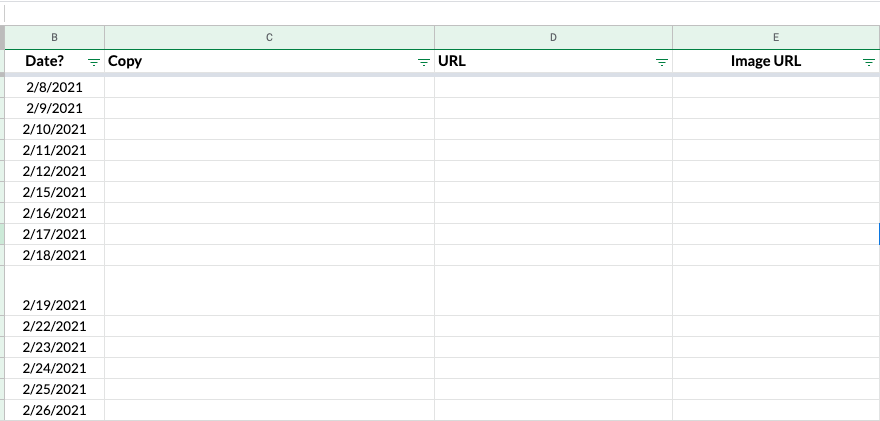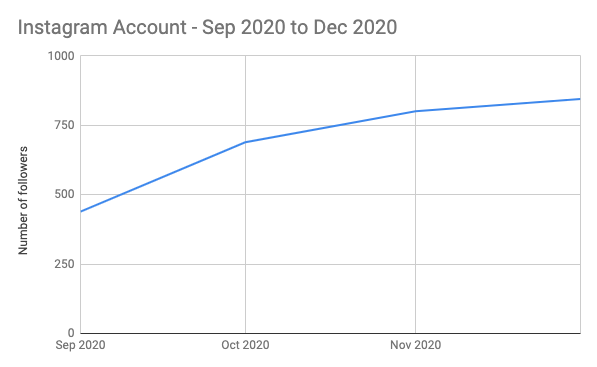
How much posting on social media is enough? The short answer is about 3-5 social posts per week.
The long answer is, ‘it depends’.
There isn’t a magic formula for this because what works for one brand, doesn’t work for another. While you can read up on case studies to see what worked for other firms, those answers might not work for you because each firm is different, had unique objectives and might be in a different stage of growth. The best thing you can do is to test it yourself.
Use the same base content but tweak the posts according to each platform.
Even if you’re essentially sharing the same message on all the platforms, the WAY you share it changes how (or if) someone actually engages with it.
Followers on different platforms like different types of content and media. Those on Instagram are generally more visual people, more creative. They like imagery, visual effects and colour. Followers on LinkedIn generally have an expectation of a more corporate environment, a more “professional” approach, and prefer short stories, videos about business topics, and content from articles.
When it comes to frequency, try stick to the following guidelines:
- Facebook: 3x per week to ensure active engagement. If you post less than that, you won’t be seen on your ideal client’s newsfeed and they’ll forget you ever existed.
- Instagram: 1x per day as this platform doesn’t seem to like multiple posts per day. In fact, beware of posting lots in quick succession as you will more likely lose followers.
- Twitter: 3-30x a day because tweets have a short shelf-life and you want your post to be seen. However, because people post so often, this means the Tweet doesn’t stay visible in a feed for very long so remember to spread your posts throughout the day.
- Linkedin: 20x per month which works out to about 1 post per week day. According to Hubspot, “What is likely happening is LinkedIn doesn’t want users’ feeds to be overwhelmed by posts by the same company, so the second post in a day that a marketer publishes can cannibalise the performance of the first.”
Be aware of the size of your fan base per social media platform. Hubspot found ‘Facebook pages under 10,000 fans experienced a 50% drop in engagement per post if they posted more than once per day.’
It’s more important to be consistent, than frequent.
Medium.com compares building a good social media brand with building a good relationship. In order to develop a relationship, you speak consistently with your partner to get to know each other and build trust. If you text someone 6 times on Monday and then don’t text them for 2 weeks, your relationship won’t be very stable. The same goes for your social media accounts.
It’s important to be consistent with your posting, but you can get creative with those posts and vary the kind of content so your audience doesn’t get bored. Depending on the platform, you can share articles, promotional posts, inspirational quotes, personal posts, client stories, new apps and software and local stories.
While one of the main purposes of posting on social media is for people to get to know your brand, remember the 80/20 rule when posting so you don’t come across as too salesy. 80% of your content needs to be about things your clients are interested in (like helpful tips, recent news that might affect them, new apps to help their processes and systems and case studies to show them you know what works) and 20% of your content can be about your firm (like the services you offer, special deals and sign-ups).
This isn’t a hard and fast rule: you might one week have it more like 70-30 and another week 90-10. For example, if you have a workshop or a new course coming out, you’ll naturally be posting more about that in the week or two running up to it, and then it will fade away a bit after that. But it’s a good guideline to be aware of – especially as accountants often fall into the trap of following the 20-80 rule (sharing mostly about themselves and their services). That doesn’t help you build a relationship or help people: it’s just salesy and focused on you.
You don’t want to put people off by sounding pushy and only providing content encouraging them to take action and buy something from you. You want to appear helpful and show them you genuinely care about them and their business.
The best way to be consistent is to create a social daily planner. This can be as simple as a Gsheet with the date, the copy, the article or page URL that you are linking to, and the image. Set aside about 2 – 3 hours once or twice a month and populate the Gsheet with images, articles, blogs, quotes and client stories that you want to share with the world.

This doesn’t need to be fully completed at the start of every month, and it will be constantly evolving, but it’s great for focus and direction and saves you time later in the month. If you have a planner, you are more likely to post more consistently. It lets you see what you are posting on which days, to make sure it’s 80/20.
With some social platforms, you can even prepare drafts to set aside and post later. A few of our team have started a new “Marketing Therapy” instagram account specifically for content related to helping accountants work through bad marketing experiences, and having good marketing health. Karen often sets aside a few hours to sketch images, write out content, and prepare posts in draft format on Instagram on her phone: and then they sit in drafts to be published day by day (rather than publishing four posts one day and nothing for two weeks).
You can do something similar using the Gsheet or even notes or an app on your phone. Actually publishing the post takes a few seconds: it’s the prep and finding an image and writing the words and choosing hashtags and preparing to tag others which takes the time. Prep for that.
Give your target audience a reason to come to your social platform.
Doing well on social media is less about how often you post and more about the content you are posting. Have something worthwhile for your ideal client to read. Is the content you are posting useful, interesting, helpful and original?
Only post if you have something helpful to share. If you just fill everyone’s social media feeds with content that isn’t useful, interesting or helpful, you can’t expect to get results. In fact, if you are just posting to fill a slot in your schedule, it’s more likely you are going to lose followers than gain them, because followers will get bored, annoyed or think you are just trying to make a sale.
Think about why you started following someone on social. What did you like about their brand? What was so appealing you wanted to see more of it? Then think about your brand. Why would someone want to follow you?
Austin Kleon’s book ‘Steal like an artist’ recommends getting inspiration from other people’s creativity. Look at other people’s social media accounts, see what you like and don’t like and get inspired. Create something from an idea you’ve already seen but make it your own. Ensure it’s on brand and adjust the principles to suit your brand/social strategy.
You might even want to look at other industries to get ideas. Pull a quote from somewhere, get an idea from a competition someone is running, or even introduce your team with short video clips like PF!
Engage, engage, engage: actually talk to people!
It’s not enough to simply send out posts 3-5 times a week. People want someone to talk to. Originally, social media platforms were set up as “social networks” and the whole point of social media was to be social and interact with other people. Your followers want to interact with real people.
You need to dedicate some time to actually interact with people on social platforms. People are not just going to sign up with your accounting firm because you’ve started a Twitter account. They need to know you exist, yes: but they also need to know what it’s like to work with you, even on a small scale: so you need to interact with them first.
Ask questions on social media people would want to answer or can’t help but answer! People love giving their opinion and experience of things. A shared experience is something people crave and it’s the perfect way to connect with someone.
Ask something like “How’s your Monday been?” or “What’s better, tacos or wraps?” People love talking about themselves so make your question about them. At PF, we have team pillars (things we strive towards) and personal pillars. At the end of last year, each team member created a short 1 minute video for Instagram talking about their personal pillars – what they were, why they chose them, how they were important to them. We then asked that people comment back with their personal pillars. Some people did, and others didn’t comment straight away but thought about it for a long time and spoke to us days or weeks or months later saying “I love your idea of pillars and I was thinking….” This series of posts helped people meet the team, get to know us a little better and think about what’s important to them….and it started conversations which continue to this day.
From this and other posts we’ve been sharing recently, we’ve been reminded that people love people. When we look at our own “PF Copilot report”, which summarises our marketing numbers for the month, the social posts which get the most engagement, the most comments, the most views, the most shares, are ALWAYS posts which relate to our team, and our clients. People. Humans. Stories. Likes. Dislikes.
Your social posts are only the first part of the conversation you have with your followers. When people comment or share your posts, reply to their comment. Don’t simply say “thanks very much” or “great!”: think about how you can start a conversation. If you share a picture of a book you’re reading and someone says “I like that book too!”, ask what specifically they liked about it. When they read it. What else they’re reading now. Start following them back and liking their posts. When you engage with them, it encourages them to continue building on the relationship.
Prospects often start as someone who is simply admiring your work and perhaps wanting to know a little more about your firm. They may not seem like a prospect at the time as they are at the awareness stage of the buyer journey. (They may not even think they ARE a prospect.) Now is the time to start building the relationship, put in the time, and show them they can trust you.
Use social media analytics to see which posts worked well and which ones didn’t.
It’s important to see which days your posts get the most engagement. Instagram followers are likely to be on the platform during the week and on weekends. Facebook followers may visit the platform first thing in the morning and again at lunch. LinkedIn followers are known to visit during the working week and take a break on the weekends. If that’s truly the case, there is no point posting on LinkedIn on a Saturday as it won’t get seen. (And yet, it could be that posting on a Saturday is one of the best things you can do for your particular followers. It varies depending on platform AND your particular following.)
So how do you know which days are the best to post on? The answer: analytics.
There are plenty of analytics options available for social media these days.
On Facebook, you can use Page Insights for free to see which posts did the best, what the engagement rate was and you can even look at your audience through demographic data like age, gender and location.
Twitter has Twitter Analytics free of charge for its users which displays the top tweet, profile mentions, profile views and number of impressions per post.
You can keep track of the performance of your LinkedIn Page with LinkedIn Page Analytics which is available on your LinkedIn Account for all Page Admins. This software shows individual post analytics as well as follower demographics and visitor analytics.
On Instagram, you can access insights from the menu icon in the top right corner of your Instagram profile. However, this is only available for Business accounts. Insights shares metrics on posts and stories and also has demographics so you see who your audience is made up of.
If you use a scheduling tool like Sendible, Hootsuite or Buffer, you can use the analytics from there as well. On a side note, we’d recommend using a scheduling tool if you plan your posts in advance (which is always beneficial) and if you manage more than one social media account. These scheduling tools can also be used alongside your daily social planner. Once you have your posts written up in your Gsheet, you can upload them in bulk as a CSV file into your chosen scheduling tool.
If you are scheduling in advance, bear in mind that things are changing in the world every day and while a post may seem fine today, it may come across as insensitive on another day because of something that may have taken place. Ensure that you haven’t got anything scheduled that might be posted at an insensitive time or have content which unfortunately relates to a world event.
At PF, we use our Co-Pilot & Tracking to track and measure all of our marketing numbers, including our social media numbers. It shows us what’s working, what’s not working and gives us opportunities to try new things. Our clients can see when they’ve been putting in more effort on their social media platforms by the number of followers and the number of people that visit their site from their social channels.
Below is an example of a client’s Instagram account over 4 months. You can see he has been posting helpful content and engaging on the platform by the steady increase of followers over the months.

It’s easier to post consistently when you know what it’s doing for you.
If you don’t know why you are posting something, you won’t have a true measure of whether it’s successful or not, because you won’t know what you’re measuring it against. What is it you want to achieve for your brand? What is your goal for social media? You may want to create awareness, sell a service or push traffic to your website.
If your goal is to sell a service and you get lots of engagement and likes but no leads, your posts aren’t successful. This doesn’t mean they aren’t helping your brand. They just aren’t meeting your objectives. Social media (and marketing in general) is a long game and you’re likely to only get leads if you have created brand awareness and spent time building relationships first.
Don’t start too big. If you are just starting out on social media, creating awareness is most important. At this point, all you want to do is make people aware of you and start to build relationships. Set yourself a challenge – do 1 post a day for 100 days. This creates good habits and starts to build up a fan base.
If you jump straight to trying to sell services to a small fanbase who don’t really know or trust your brand yet, you won’t sell very many services. If you share consistent, good quality content that is useful and helpful, you will likely get engagement on the posts which will build trust with your followers.
Content marketing and social media changes faster than we can keep an eye on. Revisit your goals often so you are taking into account the changes that may have taken place on social media platforms in terms of posting content. Posts may need to be shorter or longer, done more often or less frequently to get impact. What works for you right now, may not work next year.
Finally, remember to look at the big picture – where does your social media strategy fit in with the rest of your marketing strategy? Are you sending out consistent messages across all your marketing channels? If you aren’t yet, it may be time to take a step back and look at where you are in your marketing journey and what you are wanting to achieve.
If we go back to our question at the start and ask “How often is enough?”, I trust you see your ‘enough’ might be different to someone else’s’ ‘enough’. It’s not about “enough”, but “how much”: and that’s based on the time you’re willing to put in to think about who your posts are for, to plan what you are going to post about and when, and to engage with people to build real relationships.

